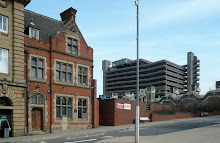
Jo Coupe
Preview: Thursday 28th May 2009 6 – 9pm
29th May – 27th June 2009
Tues - Sat, 11am -5pm (or by appointment)
Workplace Gallery is delighted to present Fade Away And Radiate a solo exhibition of new work by Jo Coupe.
Exploiting the aesthetics and methodologies of Science, the recent work of Jo Coupe adapts simple experiments and subverts half-understood scientific ideas, plundering iconic imagery for its metaphorical significance. In her work, the school science experiment, alchemy, and a fascination with decay unite to reveal the world as a mysteriously rational place.
Continuing her investigations into the objects and symbols of ritual, magic and the everyday. Coupe’s fascination with paranormal occurrences has led to extended periods of research into the powerful electromagnetic forces of the smelting rooms at one of the world's largest producers of aluminium and bauxite. In this unique environment coins levitate upwards, keys stick rigidly to walls, cameras produce ghosted and partially blacked out images, and video cameras distort unpredictably; all commonly documented symptoms of ‘haunting’ or psychic activity.
By investigating the symbolic power of the object through a holistic knowledge of the natural world and its scientific, ritualistic, and poetic usage; Coupe’s work takes on a political significance via the employment of the anti-rational and ‘magic’ - traditionally the domain of witchcraft. The setting of her practice within the macho environment of heavy industry, and her use of commonplace and domestic objects conflate two stereotypically gendered positions to move towards an analysis of objects, and the cultural and social forces at play that pervade the meanings we commonly ascribe to them.
Fade Away and Radiate consists of a new ambitious body of work including sculpture, installation, video, photography, and works on paper drawn from Coupe’s ongoing research into how specific environments can alter both the meaning of objects and their physical behaviour.
The installation 'Supernature' recreates electromagnetic and paranormal effects observed by Coupe through the combination of jewelry, gold and silver plated steel chain, furniture, and electromagnetic fields. 'Phenomena' is a series of short, looped films on separate monitors each depicting the physical effect of powerful magnets on everyday implements such as scissors, keys, and pocket knives. 'Atmospheric Disturbance' is an ongoing collection of photographs of rainbows captured by the artist during the normal course of her day: whilst traveling in her car, reflected on a dinner plate, or in the far distance. The backs of each photographic mount have been coated with fluorescent paint to create a halo of coloured light on the wall around each image. 'Infester' takes over the space with over a hundred and twenty patinated bronze casts of exotic fungi carefully mounted on brass pins, drawing attention to overlooked and undesignated areas of the historic gallery building. 'In The Field' is an object that presents us with evidence of active forces. In this case Coupe has poured resin into a Tupperware bowl in close proximity to a strong magnetic field and then mixed iron filings into the resin. The resulting work suspends the filings as they are pulled from the resin towards the magnetic source. Slab captures a more sober moment presenting a bronze cast of a tiny dead baby bird immaculately mounted on a shallow steel plinth. 'Ultraviolet' is the latest and most ambitious of Coupe’s series of works using cut out original botanical prints, in this instance 13 images of Violets are stripped of their surrounding page and meticulously joined to create a delicate web.
Jo Coupe was born in 1975 and studied Fine Art at Newcastle University and at Goldsmiths College, London. She lives and works in Gateshead, UK. Exhibitions include An Archaeology at 176 in London, Tatton Park Biennial, Give and Take at Firstsite, Colchester, and You Shall Know Our Velocity at BALTIC, Gateshead.
























